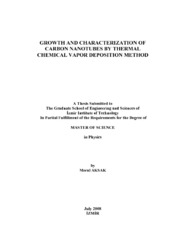Please use this identifier to cite or link to this item:
https://hdl.handle.net/11147/3940Full metadata record
| DC Field | Value | Language |
|---|---|---|
| dc.contributor.advisor | Selamet, Yusuf | - |
| dc.contributor.author | Aksak, Meral | - |
| dc.date.accessioned | 2014-07-22T13:52:47Z | - |
| dc.date.available | 2014-07-22T13:52:47Z | - |
| dc.date.issued | 2008 | - |
| dc.identifier.uri | http://hdl.handle.net/11147/3940 | - |
| dc.description | Thesis (Master)--Izmir Institute of Technology, Physics, Izmir, 2008 | en_US |
| dc.description | Includes bibliographical references (leaves: 53-61) | en_US |
| dc.description | Text in English; Abstract: Turkish and English | en_US |
| dc.description | xi, 61 leaves | en_US |
| dc.description.abstract | This thesis work is focused on producing carbon nanotubes (CNTs) by methane gas thermal chemical vapor deposition method on very thin Cobalt, Iron, and Nickel catalyst thin films deposited onto SiO2/Si substrates by DC magnetron sputtering. This thesis is also devoted to understanding some parameters affecting the growth of CNTs; such as catalyst material, temperature, and catalyst layer thickness effects In this study, CNT growth was performed on directly Si substrates, which was observed that the growth was too difficult and requiring very high temperatures. Hence, very thin catalyst films were deposited on SiO2/Si substrates, and the CNT growth was observed. The temperature effect was also examined. When the growth temperature was increased, the average diameters of the CNTs were decreased up to a critical temperature, but after this point the average diameter of CNTs were increased. This effect was studied systematically by utilizing Fe and Co catalyst thin films and with the help of Raman spectroscopy and Scanning Electron Microscopy results.Catalyst thickness effect was also examined. For this aim, Ni catalyst thin films with three different thicknesses; 0.7 nm, 1.4 nm, and 6 nm, were utilized. It was observed that CNTs were grown well on 0.7 and 1.4 nm thick Ni films, while there was a little growth on 6 nm thick Ni film. The roughness analysis of 0.7 nm and 1.4 nm thick Ni films were also done. Some of as-grown CNTs were also examined by X-ray diffraction method, and the results were compared one another. | en_US |
| dc.language.iso | en | en_US |
| dc.publisher | Izmir Institute of Technology | en_US |
| dc.rights | info:eu-repo/semantics/openAccess | en_US |
| dc.subject.lcc | TA418.9.N35 A315 2008 | en |
| dc.subject.lcsh | Nanostructured materials | en |
| dc.subject.lcsh | Nanotubes | en |
| dc.subject.lcsh | Carbon | en |
| dc.subject.lcsh | Catalysis | en |
| dc.title | Growth and Characterization of Carbon Nanotubes by Thernal Chemical Vapor Deposition Method | en_US |
| dc.type | Master Thesis | en_US |
| dc.institutionauthor | Aksak, Meral | - |
| dc.department | Thesis (Master)--İzmir Institute of Technology, Physics | en_US |
| dc.relation.publicationcategory | Tez | en_US |
| dc.identifier.wosquality | N/A | - |
| dc.identifier.scopusquality | N/A | - |
| item.openairecristype | http://purl.org/coar/resource_type/c_18cf | - |
| item.languageiso639-1 | en | - |
| item.openairetype | Master Thesis | - |
| item.grantfulltext | open | - |
| item.fulltext | With Fulltext | - |
| item.cerifentitytype | Publications | - |
| Appears in Collections: | Master Degree / Yüksek Lisans Tezleri | |
Files in This Item:
| File | Description | Size | Format | |
|---|---|---|---|---|
| T000721.pdf | MasterThesis | 7.97 MB | Adobe PDF |  View/Open |
CORE Recommender
Page view(s)
242
checked on Mar 31, 2025
Download(s)
72
checked on Mar 31, 2025
Google ScholarTM
Check
Items in GCRIS Repository are protected by copyright, with all rights reserved, unless otherwise indicated.